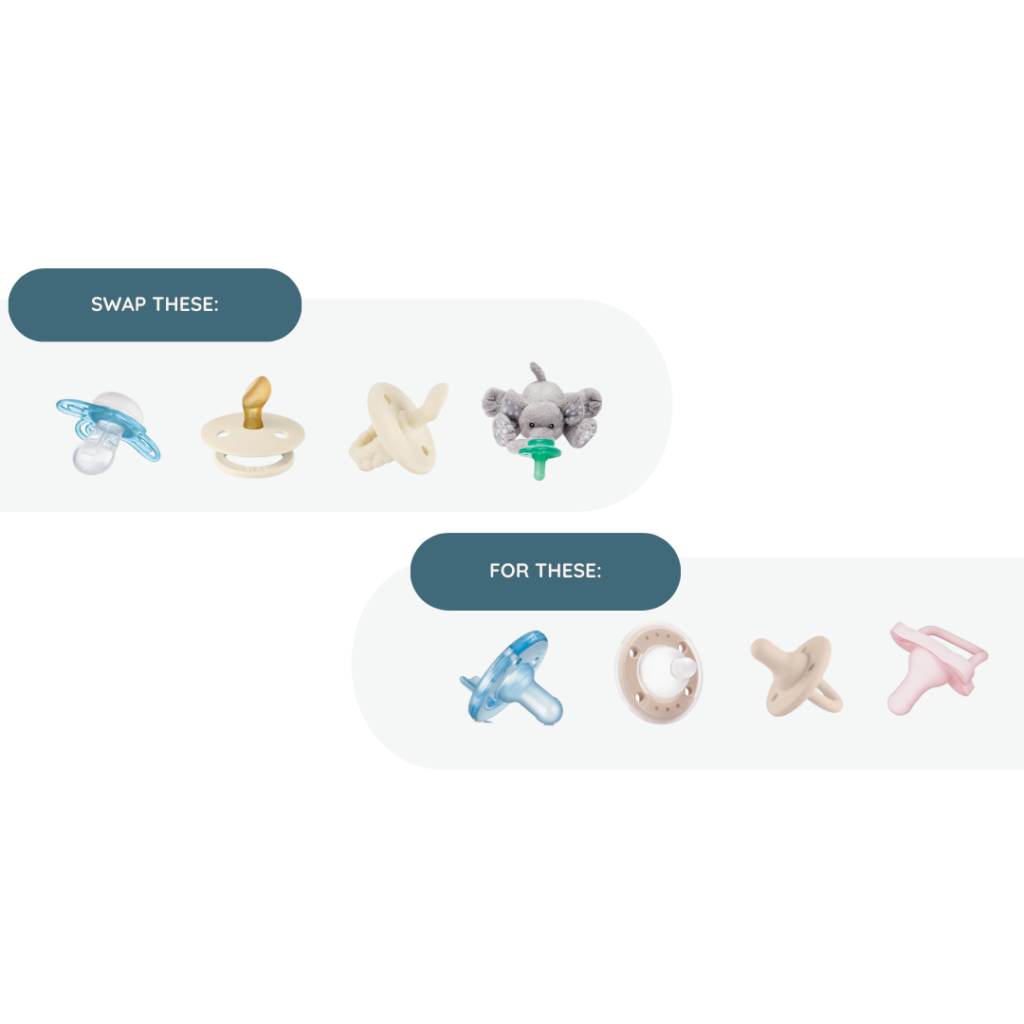There are so many conflicting opinions on pacifiers that it can confuse and overwhelm parents. And understandably so! In this post, I will share what you need to know about pacifiers from the perspective of a speech-language pathologist, feeding therapist, and lactation counselor. We’ll explore the timing of pacifier introduction, the benefits of pacifier use, and pacifier recommendations. I’ll also share a pacifier weaning timeline to provide you with some evidence based guidance if you are wanting to offer your baby a pacifier!
When should you introduce a pacifier?
Feeding therapists and Lactation Consultants recommend waiting to introduce a pacifier until your breastfeeding relationship is well-established. This can typically occur somewhere between 3 to 6 weeks. However, every mother baby dyad is different and this timing is a general guideline! Some parents introduce it earlier, while other’s a little later. If you’re reading this and your baby is ~2.5-3+ months, this can be a tricky time to introduce the pacifier because their sucking reflex integrates, meaning sucking is no longer reflexive and baby must choose to volitionally suck on the nipple.
The Benefits of Pacifier Use
When used intentionally, pacifiers can have several benefits for babies. We’ll share 5 below:
- Pacifiers are protective against sudden infant death syndrome (SIDS) when used during sleep
- Pacifiers can help calm an infant if/when they are fussy
- Pacifiers can help soothe and settle a baby to sleep
- Pacifiers can help relieve digestive discomfort and can serve as a natural pain reliever during teething.
- Pacifiers can be a helpful tool to enhance oral motor, feeding skills
My Top Pacifier Recommendations

When selecting a pacifier, opt for one-piece designs to help avoid choking hazards and ensure it’s made from safe, BPA-free materials. Pacifiers that are cylindrical in shape are best such as the Avent Soothie, Ninni, and HappyPaci . Try to avoid pacifiers that are flat, bulbed at the tip, and/or have loveys attached to them. Recent research has shown that pacifiers with plush animals attached at the ends can transmit just enough force to cause orthodontic tooth movement.
If your baby seemingly hates the pacifier, refuses it, spits it out, or only takes a flat, orthodontic nipple AND you are experiencing feeding challenges, it may be indicative of oral motor dysfunction and a functional feeding evaluation may be helpful! I offer in-home support to families in NYC, contact me today! And if you aren’t located in either of these areas, here are two directories that may help you find a preferred provider: Chrysalis Orofacial and Feed the Peds.
Pacifier Weaning Timeline
At some point, there comes a time when it is inevitably time to wean your child off the pacifier. The timing of weaning can be a bit controversial. Most experts suggest to begin the weaning process around six months and officially wean by 12 months. While this is the ideal timeline for weaning, some toddlers are obsessed with their pacifier and it can feel incredibly hard to wean at 12 months! If this is your child, please know it’s not the end of the world! You can find a timeline that may feel more manageable for your family. From a oral motor, feeding perspective, we recommend aiming to fully wean off the pacifier by 18 months and 24 months at the latest in our opinion. If you need more guidance on weaning from the pacifier, my pacifier weaning post is for you. Check it out here!
Pacifiers are controversial and they can get a bad rep, at times. We do not want babies and toddlers using them all day every day. And if they are being used it is important to plan for when you will wean off the pacifier. But in our opinion they can certainly be a helpful tool when used intentionally!
Leave a Reply Cancel reply
serving parents of babies both virtually and in-person!
Proudly Based in Northern Virginia
Visit Our Clinic in Vienna, VA
501 Church St NE, Suite 211
Vienna, VA 22180
301-615-1343
IN-OFFICE Business Hours
Monday - Thursday: 9:00 AM to 4:00 PM
Friday: 9:00 AM to 12:00 PM
Saturday & Sunday: Closed
Mom & Baby Feeding Groups
Date: Bi-weekly Friday Mornings
Time: 10 am EST
Location: In-Clinic | Cost: Free